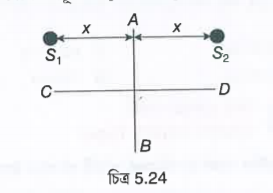একাধিক সঠিক উত্তরধমী
s1 ও s2, দুটি লাউডস্পিকার থেকে শব্দ নির্গত হচ্ছে। CD রাস্তাটি s1 ও s2 এর সংযোজক রেখার সঙ্গে সমান্তারাল । AB রাস্তাটি CD এর সঙ্গে লম্ব এবং s1 ও s2 থেকে সমদূরবর্তী সঠিক বিবৃতিগুলি নির্ণয় করো: 
AB বরাবর গতিশীল ব্যক্তি পর্যায়ক্রমে জোরালো ও মৃদু প্রাবল্যের শব্দ শুনবে
CD বরাবর গতিশীল ব্যক্তি পর্যায়ক্রমে জোরালো ও মৃদু প্রাবল্যের শব্দ শুনবে
AB বরাবর গতিশীল ব্যক্তি সমপ্রাবল্যের শব্দ শুনবে
CD বরাবর গতিশীল ব্যক্তি সমপ্রাবল্যের শব্দ শুনবে
The correct Answer is:B, C
Topper's Solved these Questions
Similar Questions
সঠিক উত্তরটি নির্বাচন করো
দুটি সুরশলাকার একযোগে কম্পিত করার ফলে উৎপন্ন স্বরকম্পের কম্পাঙ্ক হয় 4 | একটি সুরশলাকার কম্পাঙ্ক 256 Hz হলে, অন্যটির কম্পাঙ্ক
View Solutionধনাত্মক x-অক্ষ বরাবর গতিশীল একটি তরঙ্গের y-অক্ষ বরাবর সরণ 1m, তরঙ্গদৈর্ঘ্য 2πm ও কম্পাঙ্ক 1π Hz। তরঙ্গটির সমীকরণ হল
View Solutionভরসংখ্যা কাকে বলে? পরমাণুর-ক্রমাঙ্কের সঙ্গে এর সম্পর্ক কী?
View SolutionAgCl solubility in water, 0.01 (m) CaCl_2 , 0.01 (M) NaCl and 0.05 (M) AgNO_3 - A respectively S_1,S_2,S_3 ও S_4 If -
View SolutionLet the sum of n, 2n, 3n terms of an A.P. be S1,S2andS3 , respectively, show that S3=3(S2−S1)
View SolutionLet the sum of n, 2n, 3n terms of an A.P. be S1,S2andS3 , respectively, show that S3=3(S2−S1)
View SolutionLet the sum of n, 2n, 3n terms of an A.P. be S1,S2and S3, respectively, show that S3=3(S2−S1).
View SolutionIf S1,S2andS3 be respectively the sum of n, 2n and 3n terms of a G.P., prove that S1(S2+S3)=(S1)2+(S2)2
View SolutionIf the sum of n,2n,3n terms of an AP are S1,S2,S3 respectively . Prove that S3=3(S2−S1)
View SolutionIf S1,S2,S3 be respectively the sums of n,2n,3n terms of a G.P., then prove that (S1)2+(S2)2=S1(S2+S3) .
View SolutionThe sum of n, 2n, 3n terms of an A.P. are S1,S2,S3 respectively. Prove that S3=3(S2−S1)
View SolutionIf S1,S2,S3 are the sums to n, 2n, 3n terms respectively for a GP then prove that S1,S2−S1,S3−S2 are in GP.
View SolutionIf a circle S intersects circles S1 and S2 orthogonally. Prove that the centre of S lies on the radical axis of S1 and S2.
View SolutionIf S1,S2andS3 are respectively the sums of n, 2n and 3n terms of an AP.Prove that S3=3(S2−S1)
View Solutionਮੰਨ ਲਉ ਕਿਸੇ A.P. ਦੇ n, 2n, 3n ਪਦਾਂ ਦਾ ਜੋੜ ਕ੍ਰਮਵਾਰ S1, S2 ਅਤੇ S3, ਦਿਖਾਉ ਕਿ S3=3(S2−S1)
View Solution
